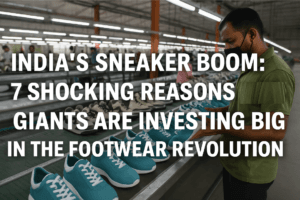India’s Sneaker Boom: 7 Shocking Reasons Global Giants Are Investing Big in the Footwear Revolution
India’s sneaker industry is experiencing a major transformation as global manufacturers and homegrown brands tap into its vast potential. Taiwan’s Hong Fu Industrial Group, a major supplier for global brands like Nike and Adidas, is building a massive factory in Tamil Nadu, aiming to produce 25 million pairs annually and create 25,000 jobs. The Indian government is backing such investments with new quality standards to improve product reliability and promote exports.
At the same time, India’s unorganised sector, which produces affordable footwear for the masses, remains dominant and crucial to the local economy. While small-scale shoemakers face challenges with new regulations, support programs aim to help them adapt rather than be pushed out. Meanwhile, startups like Zen Barefoot and Comet are introducing innovation and catering to the rising middle class with niche, high-quality products. These brands are focused on comfort, design, and materials suited for Indian conditions.
As both global and local players evolve, India is fast emerging as a serious competitor in the global sneaker market.

India’s Sneaker Boom: 7 Shocking Reasons Global Giants Are Investing Big in the Footwear Revolution
India’s sneaker market is undergoing a massive shift, attracting global attention and investment. One of the biggest moves has come from Taiwan’s Hong Fu Industrial Group — a name most people might not recognize, but whose products are hard to miss. As a key manufacturer for giants like Nike, Adidas, Puma, and Converse, Hong Fu produces around 200 million pairs of sports shoes each year, making it the world’s second-largest trainer manufacturer.
Now, the company is betting big on India. It is setting up a large manufacturing facility in Panapakkam, Tamil Nadu. Once operational — within the next three to five years — the factory is expected to produce 25 million pairs of shoes annually and employ up to 25,000 workers. This is more than just business — it’s a clear signal that India is becoming a key player in global footwear manufacturing.
Local industry leaders, like Aqeel Panaruna of Florence Shoe Company, see this move as a response to growing global competition and saturation. According to Panaruna, India offers a new and fast-growing market, especially in the non-leather footwear segment, which is seeing increased demand both locally and globally.
To support and attract such investments, the Indian government is stepping up efforts to modernize the industry. In August, the Bureau of Indian Standards (BIS) introduced updated quality guidelines that all shoes sold in India must meet. These include rigorous testing for durability, strength, and flexibility — aimed at improving overall product quality and building trust among consumers.
Sandeep Sharma, a journalist with deep insights into the footwear sector, believes this is a step in the right direction. He explains that the Indian market has been flooded with low-quality shoes for too long, and it’s time consumers got better value.
A Divided Industry: Organised vs. Unorganised
India’s footwear industry is split into two parts. On one side is the organised sector — large factories and well-known brands. On the other is the unorganised sector, made up of countless small-scale shoemakers. These small units, particularly in cities like Agra, play a critical role in meeting demand from lower-income and rural markets. In fact, they are estimated to produce nearly two-thirds of the footwear sold in the country.
Ashok, a shoemaker from Agra, runs several units that produce thousands of pairs daily. He says these small businesses help fill the gap where large brands haven’t expanded. Many customers in smaller towns still rely on affordable, locally made shoes.
However, new government standards are making life uncertain for these small players. While quality rules are necessary, Sharma believes the government is trying to balance reform with support. Rather than shutting down these operations, programs are being introduced to help them upgrade equipment and processes. The aim is to gradually bring them into the formal sector — not wipe them out.
That said, a major challenge remains — the widespread production of counterfeit shoes. Many of these are copies of international brands and are sold at a fraction of the price. While they’re popular locally, they’ve drawn criticism from global companies and international trade partners.
A Wave of Innovation from Indian Startups
As the traditional industry adjusts to new standards and competition, a wave of fresh Indian brands is emerging, targeting young and urban consumers. One such company is Zen Barefoot, which promotes minimalist shoes designed to mimic natural foot movement. Founder Sahhib Agrawal believes that while innovation is needed, Indian manufacturing often focuses on short-term profits over long-term growth. He also points out the lack of government support for startups looking to innovate.
Comet is another exciting entrant in the market. Unlike most Indian brands, Comet handles every part of production in-house — from design to manufacturing. Founder Utkarsh Gupta says this gives them better control over quality and allows them to make products suited specifically for India’s climate and roads. He’s confident that India will soon be ready to compete with the world’s top sneaker brands.
What Lies Ahead
Back in Agra, Ashok hopes the government won’t leave small manufacturers behind. He believes proper certification and support could help the unorganised sector join the formal industry and thrive alongside global players.
Sharma agrees that while big brands will likely grow faster, small shoemakers can still find success — especially those willing to adapt and innovate. “The market is evolving,” he says, “but there’s room for everyone who’s ready to change with it.”
You must be logged in to post a comment.